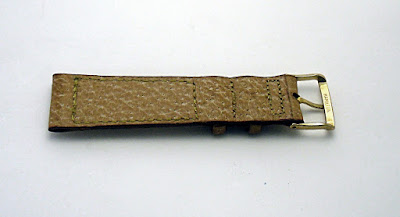I don’t know if I have a Hamilton Watch curse or it has me. I just know, I find the craziest Hamilton stuff and have fun with it.
Last week, I found a Hamilton watch band like
I restored it. I’d like to show you how I do it. Hopefully you will find this information of value.
This isn’t the first Hamilton band I restored. I managed to renew many, but I don’t have a count. This particular band fits a watch with a 20 mm lug width. I find that unusual.
I will step through the process I use, in case you ever find a NOS band – Hamilton or not. Well, I guess you can use it to bring any watch band back to life. We’ll focus on the Hamilton right now.
This band probably fell behind a counter in a jewelry store. When the estate salesman moved most of the fixtures and materials out, he came across this one.
I wanted to save this band. Hamilton made the best watches in America and even their straps surpassed their competition.
Take a close up view of this material. It’s basically awful looking. It also had a stiffness about it. I had a thought that it could break like a stale cracker.
I use mink oil to restore pigskin. It works well, so I thought I would try it on this calf leather.
I found this particular supply of pure oil in France. If you want to try restoring leather, this way, make sure you actually use real mink oil. Some companies sell a product with 5% of the real product. It does little to renew the original
I begin by scooping some oil out of the tin with my index finger. I gently coat the band. It will sink into the leather immediately and appear renewed. In a few minutes, it will appear as if nothing happened. I repeat the process several times waiting a few minutes to an hour before applying the next coat. Eventually, the strap will begin to resemble its original self.
At this point, the band feels supple. It has color, but inside the grain, you can see a white color like the picture above.
| Notice the difference between the partially treated leather and the untreated part on top |
I can’t rid the band of the white material by adding more oil. I saturated the leather and the white stuff remained. I need something else. In fact, a cotton Cue Tip served as remove the dried material in the
| Here we can start to see improvement, but flakes of grain have not disappeared completely |
 Once you finish removing the dead skin in the grain, leave the band alone over night. When you wake up, take a look and you will see that more dead skin has surfaced.
Once you finish removing the dead skin in the grain, leave the band alone over night. When you wake up, take a look and you will see that more dead skin has surfaced.
You might ask if the band will ever come back to normal. Well, I wiped the band down with a soft cotton cloth and applied more mink oil. Guess what! It soaked the oil up. At this point, I began to think of the strap as a character in one of my novels.
Two more thorough applications later, I had a nice band. When you hear someone say, “they don’t make ‘
You can’t buy a new band like this for less than $250. For example, Glashutte makes a band similar to this Hamilton with a retail price of $29
It will take approximately four to six weeks for your band to recover totally. Below, is a photo of a similar band two months from its initial condition. Keep in mind, Hamilton made the band below in 1939. I believe that’s a testimony to an American watch company bought by a Swiss conglomerate.
Click here to see Hamilton Watch Bands on eBay
Copyright 2006-2017 | All Rights Reserved


